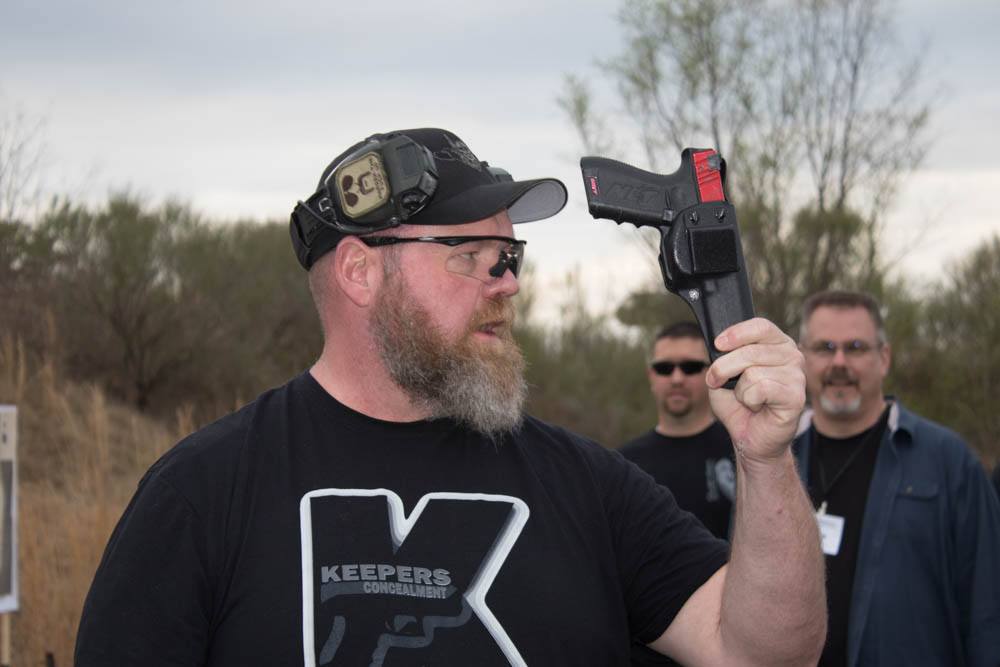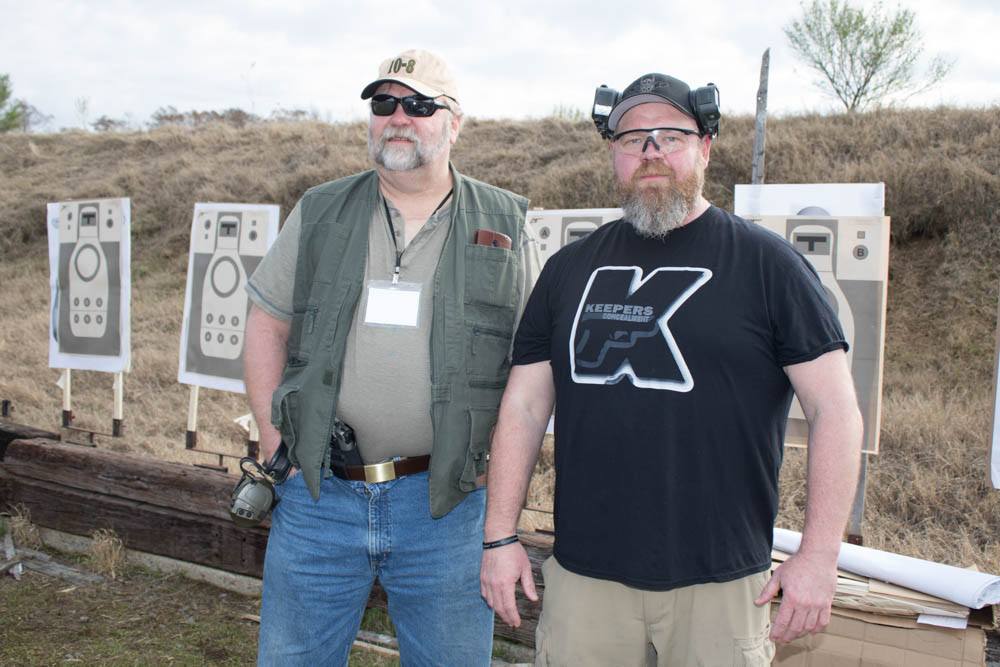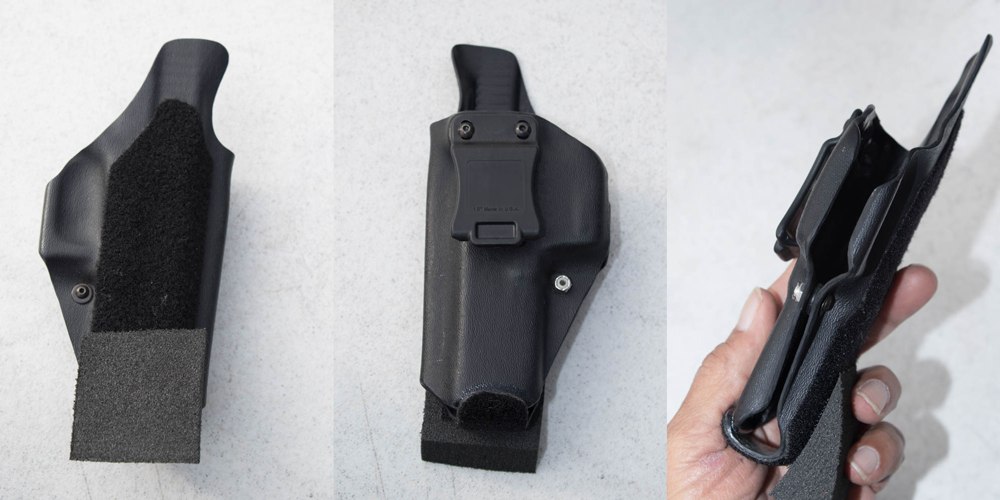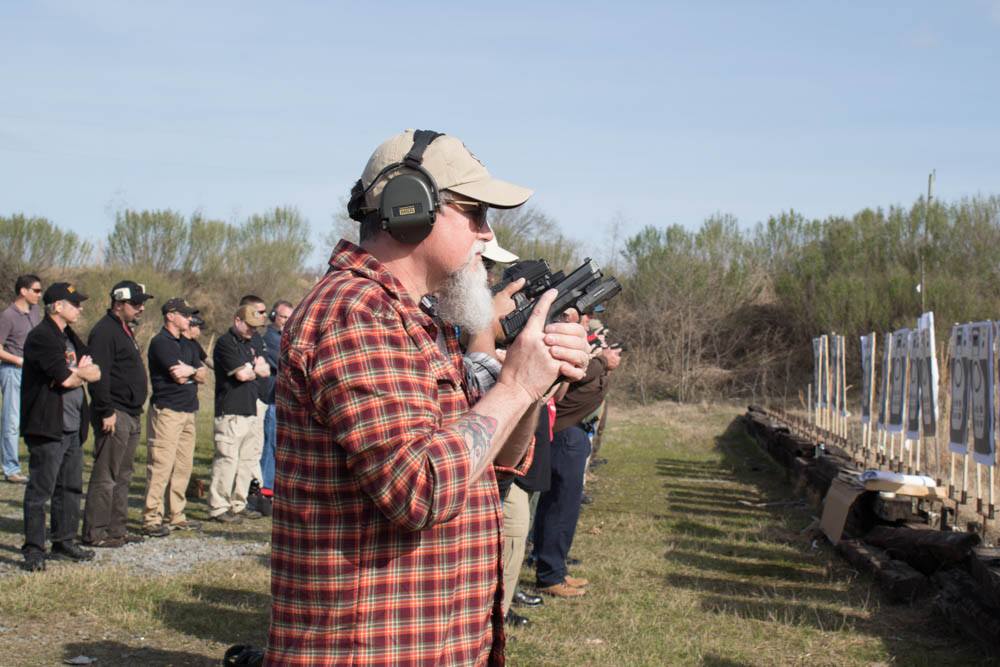
There are plenty of proponents and detractors of AIWB (Appendix Inside the Waistband) carry, but who is right when it comes to this controversial method?
The different angles on AIWB:
AIWB is shooter shorthand for Appendix Inside Waistband Carry. As the name implies, the gun is holstered between body and trousers in the abdomen area, between navel and hip, on the wearer’s dominant hand side.

Men have carried handguns in the appendix position, often tucked inside belt or sash without holsters, for as long as they’ve had handguns. In current times, this carry has always been popular in Latin America among good guys and bad alike, and most recently it has come into fashion in North America. One of the great modern instructors, Todd Louis Green, did much to popularize AIWB. Todd was taken from us in March of 2016 after a valiant decade-long battle with cancer, and though we lost him too soon, he left a large footprint. The same is true of the late Paul Gomez, another advocate of AIWB.
AIWB Advantages
As we walk through daily life or even stand still, our hands are generally closer to our front midline than our hips, armpits, ankles or other holster locations. This can make the AIWB carry particularly fast, especially if both hands are free to accomplish the draw.
The gun is very well protected against a rear grab, unless the opponent has the wearer in a bear hug from behind. It is also very defensible from a front grab.
Many people, slender folks in particular, find the gun less likely to “print” in this position than on or behind the hip, especially when sitting or bending over.
So long as seat belts don’t interfere, AIWB offers particularly good access when seated behind a steering wheel.
Some people, depending on physical build, may find AIWB the most comfortable way to carry, particularly with a large handgun.
AIWB Disadvantages
Since AIWB presumes a closed-front upper garment for concealment, a truly fast draw requires both hands – the support hand to rip the hem of the garment upward, and the firing hand to access the pistol.
Carrying a gun with its “business end” pointed at genitalia or juncture of thigh and lower abdomen gives some people the absolute creeps.
If the gun does discharge in an AIWB, results range from castration to death. The femoral artery is often in the line of fire.
For more information on concealed carry holsters check out:
- Essential Gear: Best Concealed Carry Holsters
- Buckling Up The Basics Of Gun Belts
- Pocket Holster Options For Easy Everyday Carry
- The Shoulder Holster And Its Carry Angle
- Pros And Cons Of The Appendix Carry Holster
While comfortable for some, others may experience the opposite effect. Gun length and personal preference as to waistband level will be critical in determining whether or not the holstered gun digs painfully into thigh or crotch.
Practice opportunities are somewhat restricted. AIWB carry is forbidden by some police departments, and has been banned by some top private instructors, such as Marty Hayes and Larry Vickers. AIWB is not allowed in IDPA, the “concealed carry sport,” at this writing, nor in PPC matches.
An Opposing View On AIWB
Marty Hayes, Director of the well-known firearms training school The Firearms Academy of Seattle, Inc., has some serious concerns about the safety of the practice of carrying firearms in this manner, and in fact has banned the practice at his training school. Hayes, a law school graduate, is well educated in the laws regarding civil liability, and believes that instructors who allow the practice are flirting with danger.
From his law studies, he understands that for a plaintiff to collect damages in a lawsuit for negligence, they must prove that the defendant was negligent, and because of that negligence the plaintiff was injured. He believes that firearms instructors need to conduct their training courses in a reasonable manner, using tried and true gun handling techniques that have passed the muster of time in regards to safety.
“There are decades of gun handling protocols from the 50s and beyond that have proven that wearing the gun on the side of the hip (3-4 o’clock) position is the safest way for an armed American to carry a sidearm,” says Hayes. For over 30 years, he and his staff have taught the tried and true strong-side hip draw stroke which does not involve people pointing the gun at or near their private parts.

He believes that AIWB carry is outside the common standards and practices for professional firearms instruction and, in the event a student is severely injured or killed because of a bullet to the testicles or femoral artery, that the instructor will have a difficult time defending having allowed the practice, if he is sued.
Hayes at one point allowed the practice at The Firearms Academy of Seattle, and when he saw the popularity of the technique rising, he undertook a diligent study. After his observations, he concluded that while on a square range, with students lined up like tin soldiers all in a straight line, and allowing for people to carefully and slowly holster the gun, it can be done in relative safety. But, as his courses involve stressful exercises as a training method for armed citizens to learn how to handle armed encounters, he believes that when students start moving off the line of attack while they draw, that the muzzle invariably ends up pointing at vital parts of the human body, which violates one of the basic tenets of gun safety: Never point a gun at anything you are not willing to shoot.
He is also convinced that the bullet is not the only danger. He carries a 10mm single action Commander as a carry gun, and cannot imagine the pain and burned flesh that would occur if that gun discharged while stuck inside his pants pointed at his testicles. Even if the bullet missed all vital parts, the muzzle flash would do sufficient damage to possibly incapacitate him. For these reasons, he publically has made his position well known and advocates for the practice to go away.
Advice From a Master of AIWB
Among AIWB enthusiasts, Spencer Keepers is a name to contend with. A master maker of such holsters (http://keepersconcealment.com/), he’s also a master of teaching their use. Todd Louis Green made him a believer, and Spencer has kicked some major boo-tay drawing from AIWB in competition.
He reminisces, “I realized Todd could get to his gun easier than I could. I noted Craig (“Southnarc”) Douglas carried AIWB. I prefer to carry a Glock 35 (5.3” barrel) and the first thing I realized was that I was going to have to raise my waistband. Pretty soon, I bought some Kydex and a Dremel tool.”
Spencer gives an excellent class on getting the most out of AIWB carry, and does so every year at Tom Givens’ excellent Rangemaster Tactical Conference. I made a point of showing up for it in 2017 at the DARC training facility in Little Rock, Akansas.
He began by saying, “AIWB ain’t for everybody. Holster cant and ride height are incredibly important to making it work.”

His next statement was counterintuitive, but made huge sense when he explained it. “For AIWB, longer is better, until it’s too long. Most appendix carry holster options are open ended with sharp, uncomfortable edges down by the muzzle. These can dig into the body.” The “longer is better for concealment” rationale? It’s because the forward part of the gun’s contact with lower abdomen pushes the butt end of the gun tighter against the upper abdomen.
Keepers continued, “You want some adjustability. A straight drop can work well for AIWB, but for most people, a slight rearward cant is ideal. Each person has to find the angle and position that works the best for their particular body.”
He adds, “Very short holsters tend to roll the gun butt out forward in a very obvious way. That’s particularly true if you have any belly at all. You want the appendix carry holster to fit between the ‘important parts’ and the crease in the leg. That’s one reason the FBI cant doesn’t work with AIWB.
“On our own holsters, we extend the muzzle end about an inch. We roll the material over and close the muzzle. That eliminates a sharp discomfort point. The rolled muzzle also acts as a heat shield when the gun warms up during intensive training,” Keepers concludes.
The belt, as always, is as important as the holster. “I like an infinitely adjustable belt,” says Keepers, explaining, “Hole spacing in regular leather belts is about every three-quarters of an inch. Hydration factors can cause swelling and contraction of our waistline throughout the day. I like the Wilderness three-stitch Frequent Flier. The more flexible the belt, the better.”
Keepers is aware of the fine line between enough protection to shield wearer from gun and vice versa, and the need for the drawing hand to instantly take a full grasp. “You definitely want a full firing grip on the gun,” he says, “but we also put a horn on the holster to protect the shooter’s skin and clothing from the (sometimes sharp-edged) sights. Our design is now widely copied.”

A signature feature on Keepers Concealment AIWB holsters is a foam wedge on the lower part of the scabbard facing the wearer. It performs three purposes. One is to simply enhance comfort, with a cushioning effect. But the other is for safety: the wedge levers the gun muzzle out a little bit away from the body, to mitigate the dangers of an unintended discharge striking genitalia or femoral artery. Finally, the wedge acts as an added heat shield.
Many shooters today want to carry their pistols with white light units attached. I know one rock-hard, wiry 5’6” fella who daily conceals a full-size Glock 17 AIWB, complete with attached light, and hides it perfectly. “We do make holsters for those,” says Keepers, but I have to admit I’m not a big light guy. They make a much bigger footprint in a limited space.”

Spencer teaches a thumb on the back of the hammer or slide for the same reason I do with any sort of holstering, explained elsewhere in this book. And he teaches rocking the shoulders back and thrusting the pelvis forward during reholstering, to angle the gun muzzle away from body parts you particularly don’t want to “muzzle.”
While a couple of things – mainly comfort factors and long-time habituation – have kept me from staying with AIWB every time I’ve tried it, it’s entirely possible that it will work better for you. Understand, though, that it requires diligent focus on safety. You would be wise to take competent training in AIWB before practicing it, and I can’t think of any instructor better to start with than Spencer Keepers.
This article is an excerpt from Gun Digest Book of Concealed Carry, Volume 2: Beyond the Basics.

Next Step: Get your FREE Printable Target Pack
Enhance your shooting precision with our 62 MOA Targets, perfect for rifles and handguns. Crafted in collaboration with Storm Tactical for accuracy and versatility.
Subscribe to the Gun Digest email newsletter and get your downloadable target pack sent straight to your inbox. Stay updated with the latest firearms info in the industry.

![Best Concealed Carry Guns In 2025 [Field Tested] Wilson Combat EDC X9S 1](https://gundigest.com/wp-content/uploads/Wilson-Combat-EDC-X9S-1-324x160.jpg)


![Best 9mm Carbine: Affordable PCCs [Tested] Ruger Carbine Shooting](https://gundigest.com/wp-content/uploads/Ruger-Carbine-Shooting-100x70.jpg)
![Best AR-15: Top Options Available Today [Field Tested] Harrington and Richardson PSA XM177E2 feature](https://gundigest.com/wp-content/uploads/Harrington-and-Richardson-PSA-XM177E2-feature-100x70.jpg)

I worked on two different indoor ranges in the 90’s, and early 2000’s. In ten years, we had two “reholstering” incidents, that resulted in injury. Both were strong side carry. If memory serves, one was IWB, and the other a duty belt rig.
One guy sent a FMJ .40 down the outside of his leg, following the bone, and exiting near his right knee. The other (not sure of the caliber), creased his butt cheek, but was otherwise unscathed.
Both men recovered, but I don’t think the outcome would have been nearly as good with AIWB carry.
We can preach safety all day long, and rightfully so, but mistakes WILL happen, even with experienced shooters.
I often hear the argument that “Gunfights are never won by reholstering”. Ironic, that the one time in my life I have had to draw a handgun, I also needed a fast reholster, and “both hands on” ability.
I am sure AIWB works great for many, but I am not personally sold on it.
As always, YMMV.
Good article, discussing both sides of the issue.